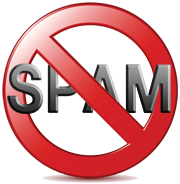Use Your Gmail Account to Filter Spam
Thursday, July 7th, 2016 I have had a gmail account setup for a number of years, but really haven’t been getting much use out it since I prefer to use my personal email based on my own domain name, which is of course registered and hosted with register4less.com. The one thing gmail does actually do quite well is filter spam with a low rate of filtering out valid email. There are a number of reasons I recommend to use an email address based on your own domain, including branding, portability, tie-in with your website, but that’s not the focus of this post.
I have had a gmail account setup for a number of years, but really haven’t been getting much use out it since I prefer to use my personal email based on my own domain name, which is of course registered and hosted with register4less.com. The one thing gmail does actually do quite well is filter spam with a low rate of filtering out valid email. There are a number of reasons I recommend to use an email address based on your own domain, including branding, portability, tie-in with your website, but that’s not the focus of this post.
Gmail allows you to forward incoming messages to your gmail address to any other external address, and this is what allows you to flow your email to gmail and back to your domain based email address for filtering. Here are the steps:
Setup on Gmail:
- If you don’t have a gmail account, go to their website and create a free account
- Log into your gmail account, and go to Settings page, and then to the Forwarding and Pop tab.
- In the Forwarding option, set gmail to forward all email to your domain based email address, and keep a copy in inbox on your gmail account.
Setup on R4L:
In this example, I will use the example email address johndoe@gmail.com and john@doe.com (both not real addresses, so please don’t email them). My apologies if Mr. Doe receives additional email as a result of this post 🙂
- Log into your account on Register4Less.com and go to the cPanel (Paid Hosting > Manage Advanced Hosting) where you normally manage your email accounts.
- Click on Email Filters, and then your email address (john@doe.com in this example)
- Click the blue Create Filter button
- Give the filter a name (gmail filtering)
- Under rules, choose Any Header and does not contain
- In the box below, enter in the text X-Forwarded For: followed by your gmail address and then your domain based address. In our example, that would be X-Forwarded For: johndoe@gmail.com john@doe.com .
- Under Actions, choose Redirect to Email, and in the text box below enter in your gmail address. Again in our example, you would enter in johndoe@gmail.com .
- Click the blue Save button
That is the entire setup. Your email will now forward to gmail (spam included), be filtered, and then forwarded back. The filter in your R4L account checks to see if the email was forwarded from your gmail account, and only if it finds that the email did not come from there will it forward to gmail.
You may know that Register4Less.com automatically backs up all of our hosting accounts on a daily basis for one week, and on a weekly basis for four weeks. Setting up this forward will also create an additional backup for you, as all of the email that is forwarded to your gmail account will stay in the inbox there as well.
Please give this a try and let us know how it works for you.

 Register4Less.com has been providing free Whois Privacy service to our customers since the we first introduced this service back in 2002. We were one of the first domain name registration providers to introduce Whois Privacy. We are one of the few domain name registrars who still provide this essential service at no additional cost to our customers.
Register4Less.com has been providing free Whois Privacy service to our customers since the we first introduced this service back in 2002. We were one of the first domain name registration providers to introduce Whois Privacy. We are one of the few domain name registrars who still provide this essential service at no additional cost to our customers.